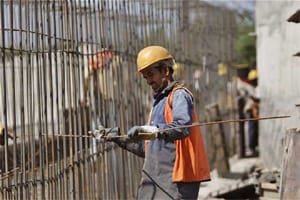In terms of the demand side, private final consumption was projected to grow at 7.1 in FY15 but grew just 6.3%, and government expenditure rose just 6.6% as compared to the projected 10%. Rural expenditure has performed worse than urban ones and this got exacerbated as the year went by – in Q4FY15, while passenger vehicle sales grew 3.95%, two-wheeler sales which have a higher rural component contracted 0.25%. Investment growth, not surprising given the local and global demand situation as well as the high excess capacity – cement capacity utilization is at 71% and automobile at 63% according to Crisil – continues to remain poor. As compared to 33.6% of GDP in FY12 according to the new GDP series, gross fixed capital formation was 29.7% in FY14 and fell to 28.7% in FY15.
The question then is what this augurs for the current year where, going by the budget numbers, nominal GDP is expected to grow at 11.5% since the boost to GVA from lower input prices and lower oil subsidies will no longer be available. And, as National Statistical Commission Chairman Pronab Sen said after the GDP data was out, the efficiency gains that boosted manufacturing growth over the last 2 years may have run their course. In which case, boosting private consumption is critical, as is the role of RBI – most analysts are penciling in a 25bps rate cut on Tuesday. Certainly, as chief economic advisor (CEA) Arvind Subramanian has argued, there is enough comfort on the inflation front even if there is a deficient monsoon. With cereals accounting for nearly a tenth of the entire CPI basket—and more than a fifth of the foods and beverages component—as compared to under 7% for fruits and vegetables whose prices tend to rise the most in a poor monsoon year, the government can dump grain to dampen inflation. While pulses inflation will rise – indeed, it has been rising, to 12.5% in April – inflation in oil and fats continues to fall in line with global prices. Whether a 25bps will move the needle, of course, remains a question – BRICS Bank chairman-designate KV Kamath’s view is nothing short of 200bps will do the trick. This may be a bit extreme, and Crisil reckons a combination of lower inflation, oil prices and normal growth will impart an extra Rs 1.4 lakh crore of consumption power in FY16, or a 2% hike in normal spending – but if consumers don’t see an improvement in jobs prospects or see inflation trending up, the money could well get channelized into savings instead.
A 25bps rate cut, assuming it takes place and banks pass this on, may not do much for spurring investment demand in the current circumstances – Crisil is looking at private investment picking up only in FY17 given how over-leveraged India Inc is, particularly in the case of infrastructure firms, and the CEA is also looking at only consumption and public investment as short-term growth-drivers. What a rate cut will do, however, is to provide a big relief to stressed corporate balance sheets – going by the outstanding loans of banks today, to all sectors, a 25bps rate cut translates into savings of Rs 17,500 crore a year. While this gain is a recurring one each year, it is worth keeping in mind that a 25bps rise in the deficit will lead to a Rs 35,000 crore increase in government investment – breaching the deficit makes sense only if the money is spent on investment – which is a far bigger short-term growth driver; it has to be mentioned that, as has been argued by FE before, if the FM were to reduce FCI’s buffers to even the expanded norms or sell his SUUTI shares, this money can be got without breaching the deficit.
Whether banks will pass on the repo cut, assuming it is made, is another story. Of the 50bps cut by RBI since January 2014, only 15bps have been passed on, and that too after a visibly annoyed RBI Governor said he wouldn’t cut rates till this was done. The problem, however, is that with bank deposits growth at a 51-year low of 11.42%, banks are in danger of seeing a further fall in this with another rate cut. Most small savings schemes run by the government offer higher rates than banks do, and they even have a tax advantage – PPF offers 8.7% while Sukanya Samriddhi offers 9.2%. So banks are unlikely to pass on all the rate cuts. While higher public sector investment and slowly limping back private consumption remains this year’s only hope – a full-fledged investment recovery cannot take place till banks force promoters to deleverage by selling assets – the monsoon is the other imponderable. Crisil’s 7.9% projection for FY16 gets reduced to 7.4% in the case of a poor monsoon – heavy pre-monsoon showers will certainly lower soaring temperatures, but they will also lower the monsoon’s intensity, and GDP growth.
For Updates Check Economy News; follow us on Facebook and Twitter
